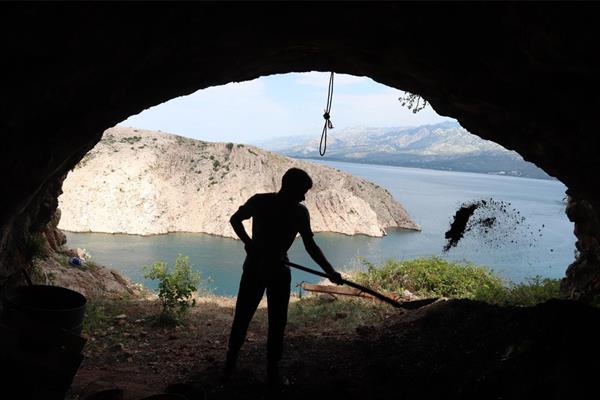
In June, a team from the Department of Archaeology at the University of Zadar resumed excavations in the Ždrilo cave, which is located in an inaccessible place above the Novigrad estuary. This year's excavation campaign, led by Mario Bodružić and Dario Vujević, focussed on Neolithic layers that shed light on how prehistoric communities used this unique site between the sea and the mountains.
Ždrilo Cave, located on steep cliffs above the bay of Novigrad near Rovanjska, is one of the most important archaeological sites on the Dalmatian coast that have been explored in recent years. It is a multi-layered archaeological site that bears witness to the use of the cave over thousands of years, dating back to the Neanderthal period.
Building on the results of trial and systematic excavations in 2021 and 2023, the Department of Archaeology at the University of Zadar continued its work in June this year, focusing primarily on the exploration of the younger layers, which are dated to the Early and Middle Neolithic. In addition to Mario Bodružić and Dario Vujević from the Department of Archaeology at the University of Zadar, an interdisciplinary team of experts from various fields was involved in this year's research campaign. Particularly noteworthy is the collaboration with the BivalveSPEECH project, led by Dr Melita Peharda from the Institute of Oceanography and Fisheries in Split.
The aim of this project is to reconstruct the palaeoenvironment and seasonal patterns of human occupation of the cave during the Neolithic period by analysing shell remains found in the cave layers — information that can shed new light on the lifestyle, diet and economy of the first farming communities in the region around 7,000 years ago. The team’s main focus is on the discovery and analysis of artefacts such as stone tools, personal jewellery and animal remains, as well as the collection of samples that are crucial for reconstructing the environment during the last Ice Age.
Ždrilo Cave proved to be an excellent site for this purpose. The Pleistocene layers of the cave, explored during the 2023 campaign, revealed at least two phases of human occupation, confirmed by radiocarbon dating, dating from the early Upper Palaeolithic and Middle Palaeolithic. This makes the site one of the few places in Europe where both Neanderthals and early modern humans lived.
Further research focussing on the older layers is planned for October, when the regular team of researchers and students from the University of Zadar will be joined by colleagues from Italy and the Institute of Anthropology in Zagreb. The cooperation between Croatian and international institutions, the application of modern archaeological methods and the involvement of young researchers and students make Ždrilo Cave a prime example of how local findings can be linked to global questions about the origin and development of mankind.
The excavations are supported by the international Last Neandertals project, which is funded by the European Research Council (ERC Synergy Grant). The aim of this project is to better understand the transitional period between the extinction of the Neanderthals and the arrival of early Homo sapiens in Europe. The main researcher is Prof Francesco Berna from the University of Siena; the participating institutions include the Universities of Bologna, Haifa, Pisa and Cologne.